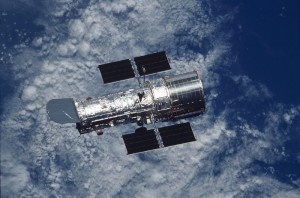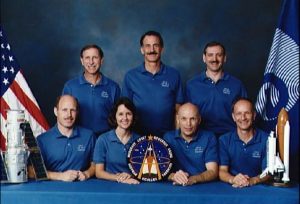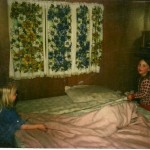vacuum
 When most of us think of outer space, we think of a place that is quiet and still, like floating through a vacuum. I suppose that some of that is true, but while things do float around in space, they can also crash into other things floating in space. I don’t know if collisions in space make a sound, but I suspect they do. I don’t know how two objects can collide quietly, but maybe the sound does occur, and then doesn’t carry. Whether there is a sound or not, those space collisions are not soft hits, and damage can occur.
When most of us think of outer space, we think of a place that is quiet and still, like floating through a vacuum. I suppose that some of that is true, but while things do float around in space, they can also crash into other things floating in space. I don’t know if collisions in space make a sound, but I suspect they do. I don’t know how two objects can collide quietly, but maybe the sound does occur, and then doesn’t carry. Whether there is a sound or not, those space collisions are not soft hits, and damage can occur.
After NASA first put the Hubble telescope in orbit in 1990, scientists realized that the telescope’s primary mirror had a flaw called spherical aberration. Basically, the outer edge of the mirror was ground too flat by a depth of 2.2 microns. That is about as thick as one-fiftieth the thickness of a human hair. I don’t know how that could make much difference, but this aberration resulted in images that were fuzzy because some of the light from the objects being studied was being scattered. While this was not caused by other objects in space, it had to be repaired anyway. The Corrective Optics Space Telescope Axial Replacement, or COSTAR, was developed as an effective means of countering the effects of the flawed shape of the mirror. COSTAR was a telephone booth sized instrument which placed 5 pairs of corrective mirrors, some as small as a nickel coin, in front of the Faint Object Camera, the Faint Object Spectrograph and the Goddard High Resolution Spectrograph. The fix worked, and while this was not the only repair job done on the Hubble Telescope, it was the first.
NASA arranged a repair mission SM1, or Shuttle Mission: STS-61 to make the repair. The mission took place on  December 2-13, 1993 in the Shuttle Endeavor. The mission, however, was not just to fix a flaw in the original design, which would have been logical when we think of how much we depend on the Hubble Telescope, but the crew also installed and replaced other components including: Solar Arrays, Solar Array Drive Electronics (SADE), Magnetometers, Coprocessors for the flight computer, Two Rate Sensor Units, Two Gyroscope Electronic Control Units, and a GHRS Redundancy Kit. The crew included Commander Richard O. Covey, Pilot Kenneth D. Bowersox, Payload Commander F. Story Musgrave and Mission Specialists Kathryn C. Thornton, Claude Nicollier, Jeffrey A. Hoffman and Tom Akers. The mission successfully made the repairs to Hubble.
December 2-13, 1993 in the Shuttle Endeavor. The mission, however, was not just to fix a flaw in the original design, which would have been logical when we think of how much we depend on the Hubble Telescope, but the crew also installed and replaced other components including: Solar Arrays, Solar Array Drive Electronics (SADE), Magnetometers, Coprocessors for the flight computer, Two Rate Sensor Units, Two Gyroscope Electronic Control Units, and a GHRS Redundancy Kit. The crew included Commander Richard O. Covey, Pilot Kenneth D. Bowersox, Payload Commander F. Story Musgrave and Mission Specialists Kathryn C. Thornton, Claude Nicollier, Jeffrey A. Hoffman and Tom Akers. The mission successfully made the repairs to Hubble.
 Children love to help. They see the things their parents or grandparents are doing, and they want to do those things too. All too often, the parents or grandparents think the child is too little to help, so they tell them to go play. In my opinion, that is a big mistake. Children can learn to be helpers at very young ages, if given the opportunity, they can become very good at it…maybe even experts.
Children love to help. They see the things their parents or grandparents are doing, and they want to do those things too. All too often, the parents or grandparents think the child is too little to help, so they tell them to go play. In my opinion, that is a big mistake. Children can learn to be helpers at very young ages, if given the opportunity, they can become very good at it…maybe even experts.
When my girls were little, they loved helping me with the household chores, and they got very good at making beds, vacuuming floors, washing dishes, washing clothes, and many other household chores. I know everyone teaches their kids to do chores, but when I have told people how young they were, they always seem surprised…like a child that young can’t possibly be trusted with some of the machines my girls used. No, they weren’t 3 years old or anything, when were washing clothes, but they were 7 and 8 years old. And they did it very well.

My nephew, Barry always wanted to help his grandpa. My father-in-law was Barry’s best friend, and if Grandpa was doing something, then that was what Barry wanted to be doing. When a child shows such an interest in something, it is easy to teach them to actually do it. By the time Barry was 5 or 6 years old, he was running a wood splitter with my father-in-law just like an expert. Barry was there to help split wood, when Bob and my brother-in-law, Ron couldn’t be there, either because of work or school, and he proved himself to be invaluable.
When my own grandchildren were 10, 10, 9, and 7 years old, they helped us with the daily care of my dad when he was very ill. They didn’t care what we asked. They were willing to learn, and more importantly, they were willing to do. Today they have gone on to do other things, since they are 16, 16, 15, and 13 years old, but they still know how to be caregivers, and they are still willing to help in whatever way we ask of them.
 Children are never too young to learn to be helpers. Sure we have to try to make the jobs we give them be something they can do at their age, but sometimes they will surprise you by being able to do things that are way beyond their years, as was the case with Barry and the splitter when he was 5 or 6 years old, or my granddaughter, Shai when she single handedly took care of my parents all day when they and we could not, and she was only 10 years old, or my grandson Josh, who so completely understands the needs of my in-laws, and who quickly catches on to the new treatments we need his help with, and is so meticulous in the performance of the duties we give him. Children truly are never too young to learn, if we give them a chance.
Children are never too young to learn to be helpers. Sure we have to try to make the jobs we give them be something they can do at their age, but sometimes they will surprise you by being able to do things that are way beyond their years, as was the case with Barry and the splitter when he was 5 or 6 years old, or my granddaughter, Shai when she single handedly took care of my parents all day when they and we could not, and she was only 10 years old, or my grandson Josh, who so completely understands the needs of my in-laws, and who quickly catches on to the new treatments we need his help with, and is so meticulous in the performance of the duties we give him. Children truly are never too young to learn, if we give them a chance.

